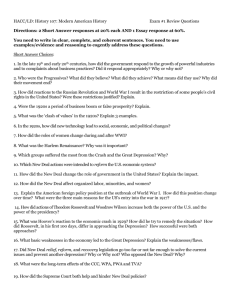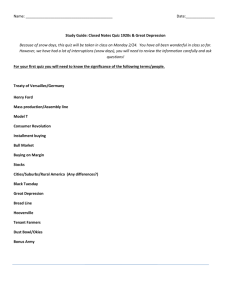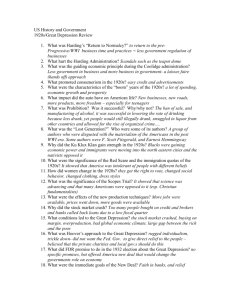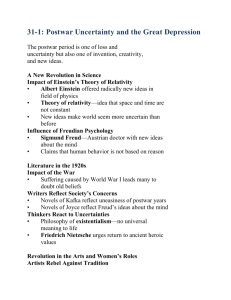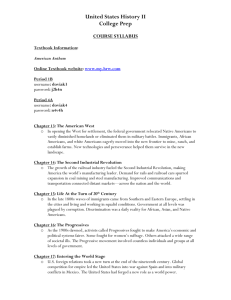depression.doc
advertisement
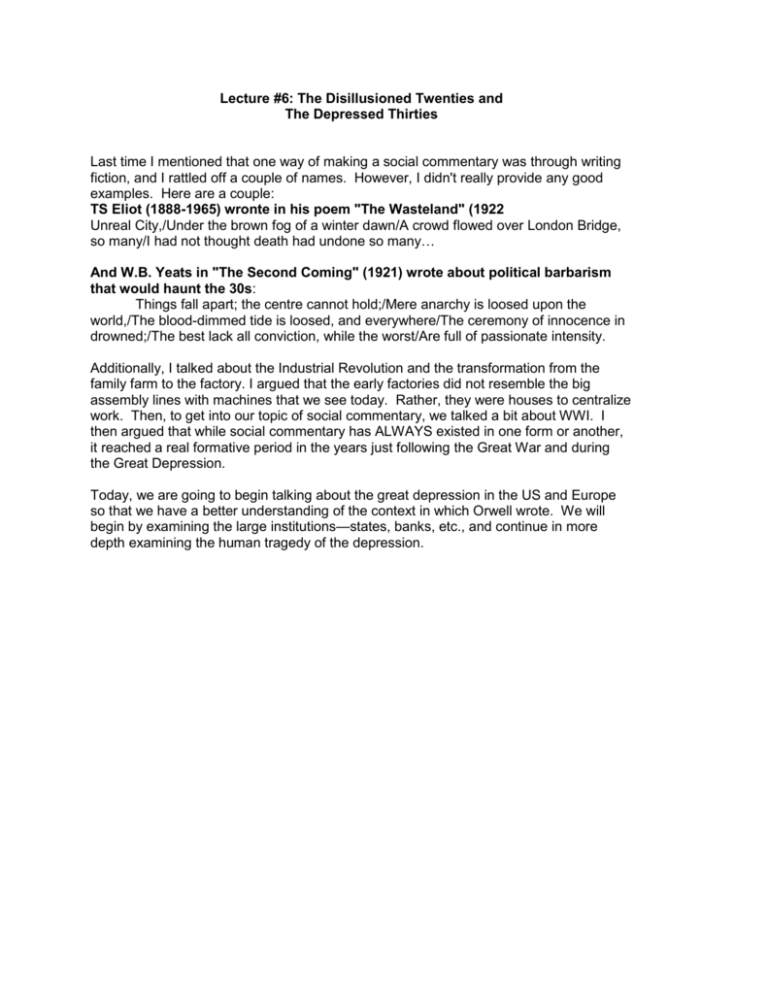
Lecture #6: The Disillusioned Twenties and The Depressed Thirties Last time I mentioned that one way of making a social commentary was through writing fiction, and I rattled off a couple of names. However, I didn't really provide any good examples. Here are a couple: TS Eliot (1888-1965) wronte in his poem "The Wasteland" (1922 Unreal City,/Under the brown fog of a winter dawn/A crowd flowed over London Bridge, so many/I had not thought death had undone so many… And W.B. Yeats in "The Second Coming" (1921) wrote about political barbarism that would haunt the 30s: Things fall apart; the centre cannot hold;/Mere anarchy is loosed upon the world,/The blood-dimmed tide is loosed, and everywhere/The ceremony of innocence in drowned;/The best lack all conviction, while the worst/Are full of passionate intensity. Additionally, I talked about the Industrial Revolution and the transformation from the family farm to the factory. I argued that the early factories did not resemble the big assembly lines with machines that we see today. Rather, they were houses to centralize work. Then, to get into our topic of social commentary, we talked a bit about WWI. I then argued that while social commentary has ALWAYS existed in one form or another, it reached a real formative period in the years just following the Great War and during the Great Depression. Today, we are going to begin talking about the great depression in the US and Europe so that we have a better understanding of the context in which Orwell wrote. We will begin by examining the large institutions—states, banks, etc., and continue in more depth examining the human tragedy of the depression. Sayegh lecture 6 Great Depression, page 2 I. Recapitulate Life after the War—Life after the war was hard. People had to face the fact that family members wouldn't return home, that their "home" may have been destroyed by fighting because of the introduction of "total war" (especially people whose villages were on the fronts) and that they literally had nothing to go home to. But the task of picking up the pieces had to begin. A. France loses status as world power Politically, the Allied Powers saw as much instability as Germany. The French went through seventeen governments between 1920-1929. They lost lots of men, their country was in a shambles and they became economically dependent on the other western nations. In England, it was the beginning of the end of her status as an international power. The liberals went into permanent declin. The US was run by business-friendly conservatives who encouraged economic isolationism, which was disastrous for Europe. B. Germany and spiraling inflation Germany of course faced the toughest problems of the western nations. Why? First, they lost the war and had to take full responsibility. In addition to the territory Germany gave up in the armistice, they had to pay reparations that were set by the Allies (basically the French and English here). Those payments were set at $35 billion. Germany couldn't pay that kind of money, period, and before 1922, the Allies made no concessions on payment plans. Thus, in the twenties, Germany faced spiralling inflation, political instability (lots of assassinations and attempts at revolution); in short, the Weimar Republic never really attained a foothold. An example of the spiralling inflation is this: in 1914, $1:4.2 DM; beginning of 1923, $1:1800 DM; and fall, 1923 $1=4.2 million DM. People spent their life savings for a stamp or a turnip. One turnip cost 50 million DM/ This bad economic situation led ultimately to the rise of nazism. C. Land decimated D. People decimated, too II. Big Business in the 1920s A. Pro-Business Governments Economic growth throughout the 20s had been sluggish at best, and while industries may have advanced, this was due primarily to modernization techniques; it didn't accurately depict their ability to compete, especially with the non-western nations who were beginning to give the western industrial states a run for their money (esp. japan). In Great Britain, there was a brief spurt of economic recovery around 1927; in France people were never told the exact count of the casualties… The twenties were a time of "big business" of a rejections economically, of the socialism of the prewar years (especially with the rise of the Soviet Union). These policies set the stage for the 30s. 1. US—the Roaring 20s 2. Riding High on the Market B. Failure of Labor to make change 1. UK—failure of general strikes Basically got the franchise across the board in the twenties because of their efforts during the war. It wasn't good politics to sort of forget them. But their connections to socialism still proved spooky for countries keeping a watchful eye Sayegh lecture 6 Great Depression, page 3 on the USSR. You really get a sense of this, I think in DandO when Orwell talks about the secret meeting with the fake Russian communists. Since the 20s were a period of business, labor fell to the wayside. Even general strikes proved ineffective. GB—1926, dockworkers and miners struck against lowering of prices in the rhineland. Joined by railwaymen and other workers. Ultimately lost the strike. MC turned against the workers, cont'd reduction of wages lowering standard of living of wc. Left a legacy of bitterness among british workers that really continues to this day—the full monty France—policy of deflation, just like GB to keep price of manufactured goods low, kept wages down. 1920s was a period of major strkes but was curiously followed by a drop in union activity. Primarily because had a labor shortage. Immigrants from colonies and eastern Europe filled the gaps. France also passed a social insurance progam in 1930 for sickness, old age and death…this is more than the other allies did. Germany workers hurting along with everyone else. US big violent strikes 1936-37 sit-down in Flint/Detroit area, AFL-CIO. III. Factors Leading to Great Depression (in US) It started in late 1929 with a crash of the NYSE from irresponsible investing and quickly spread to Europe. Historians provide three causes of the depression: 1. war—distorted world trade which couldn't be readjusted very quickly after 1918. There was overproduction in industry and agriculture, especially with the rise of the US and Japan. By middle of the 1920s, prices dropped quickly. 2. No capital to keep Europe going. Needed continued lending by the US to assure growth in Europe. Great Britain, $1B for US supplies. France lost half of her foreign investments (1/4 in Russia) 3. US policies—called "irresponsible and self-contradictory." It was a New Creditor. Their foreign investments skyrocketed during this period. From $2B in 1913 to $15B c. 1930. But policy of isolationism shielded it from investments. Specifically, in the US however, there were other problems / factors leading to the Great Depression. Throughout the 1920s, there was a lot of the following: A. Overproduction—farmers produced increasing amounts of goods throughout the 1920s to make up declining crop prices. To make ends meet, they had to sell MORE. But it wasn't just the farmers who overproduced. Large industries like coal and textiles also produced more than they could sell. B. Underconsumption—Tied together with overproduction is the fact that people weren't making lots of money in the 1920s despite the ideal of a booming economy. As a consequence, they stopped buying products. Workers produced goods but could never afford to buy them. Since the goods they produced weren't being bought, many workers were laid off. Sayegh lecture 6 Great Depression, page 4 C. Bitterness over international finance—many heads of industries were bitter about US funds going overseas to help rebuild war-torn economies. The US sent money in the form of loans to France, England AND Germany (to help it pay reparations). According to Calvin Coolidge in response to a query to just cancel war debts 'cause people couldn't pay up anyway, "They hired the money, didn't they? Let them pay it!" Continued to have HIGH tariffs for imported goods, so countries aren't really getting any profit/income to pay debts back. According to the president of Chase National Bank, "The debts of the outside world to us are ropes about their necks, by means of which we pull them towards us. Our trade restrictions are pitchforks pressed against their bodies, by which we hold them off." IV. The Crash of The US Stock Market A. What Goes Up, Must Come Down—Despite the problems others saw and felt in the 1920s, the stock market continued to climb. Many people decided to speculate, seeing the possibilities of getting a quick buck; however, cash was not always readily available, so people borrowed money to purchase their stocks and used their stocks to back up their loans. This would create a circular problem. B. Black Tuesday, October 29, 1929— the Thursday previous to this, there was a sharp downturn in selling on the market. However, heads of big industries like JP Morgan, bought stocks like US Steel to artificially stabilize the market. This didn't help C. Panic Selling across Country—it didn't help because word still spread across the nation that the market faced a huge decline. Consequently, people were in a panic to sell their swiftly declining stocks. Money was lost all over the place. Brokerage houses that lent money to people to buy stocks recalled their loans, but these same people couldn't pay since their stock's value rapidly plummeted. D. Recalling Loans to Europe—In addition, the US government thought that the best way to get back in sync economically was to have the loans out to Europe recalled. IF the banks received money back from the Europeans, the American economy would stabilize. But as I've already argued earlier, this was an irresponsible fiscal policy, as the Americans knew that there was no way these loans could be repaid so quickly E. Banks "lost" people's savings—As a consequence, since banks and the federal government didn't ensure people's money (today we generally only bank at places that insure our deposits, usually for 100,000). Many people who were laid off were forced to mortgage their houses, or were forced onto the streets into shanty towns. -pre- FDIC -note "It's A Wonderful Life" V. What about the People? A. Unemployment Sayegh lecture 6 Great Depression, page 5 1. Federal Relief—I've just mentioned that many people lost their savings. Some have argued that the Great Depression was the Great Leveller in American Society because it didn't completely discriminate between rich and poor. 2. Lost Savings = No security B. Farmers—traditionally, American society views the farmer as the great independent worker, a worker who doesn't rely on anybody else to make his living. However, this is imprecise. The farmer is subject to the whims of the market and to the whims of the buyer to make his living. If people don't buy his goods, he has to lower the price in order to sell it. 1. Overproducing—we found this happening in the 1920s. I mentioned that the farmer compensated the lowering prices of his goods by producing more. This worked for awhile. Farmers even tried to work together to halt the economic downturn buy bidding low on friends' farms to give it back. Additionally the Farmers' Holiday Assocation was formed and its leader, a man named Milo Reno, "encouraged people to take a holiday—to keep their products off the market until they commanded a better price." (US 731). But this wasn't realistic, since prices couldn't get better. People weren't always buying low because they were stingy. There genuinely was a drop in demand because PEOPLE COULDN'T AFFORD IT! 2. Others not buying goods—but the fact remained that people still weren't buying the goods he grew. So he had a hard time of it in the 1920s 3. Tenant Farmers—then there were the farmers who didn't really own their land at all, they merely rented the land which they farmed. Many of these people (especially from Arkansas, Tennessee and Texas) left their homes in the South to find a better life in the west. The Song for today ("Do Re Mi") depicts this mass migration. 4. The Dust Bowl—Many of these migrants also came from what is known as the Dust Bowl, which you had to read for today. One of the consequences of overproducing foodstuffs was that the land did not get enough time to heal itself, to rejuvenate between harvests. Thus a lot of the thick soil became degraded and suffered from erosion. Nothing could grow in this wasteland. Lecture 7: The Great Depression, Cont'd I. Introduction Last time we examined the Great Depression and its causes. First, we looked at the 1920s and saw that the era of "good times" of jazz and flappers was not so hot as it tends to be depicted. Farmers had it rough Sayegh lecture 6 Great Depression, page 6 throughout the 1920s. European countries were really hard hit by the aftereffects of the war, etc. We then looked at the causes of the International depression (war, no European capital, bad US fiscal policies) and of the domestic (US) depression (overproduction, underconsumption, bitterness over international finance). We then looked at the crash of the US stock market and very quickly discussed the effects of the crash on the people. Today we're continuing our discussion of the depression by taking a slightly deeper look at the lived experience of people who were "down and out" during this time. Then I will set us up for our discussion of Orwell on Monday by an examination of his life and writing. II. In the Country A. Agricultural Output—as mentioned last time, farmers produced more to make up for dropping prices. They did this on the former grasslands in OK, KS and TX. These lands consequently suffered erosion and thus in the drought years of the 1930s the DUST BOWL engulfed them. B. Tenant Farmers—but as noted in Davidson and Lytle, farm owners weren't the only people who suffered during this period. Many people who RENTED the land they worked lost their incomes and their homes because they couldn't pay their expenses. According to one farm owner in Missouri responding to the creation of crop subsidies (payments for reducing agricultural production): "I bought tractors on the money the government give me and shet o' my renters…They got their choice—California or WPA." (Gregory 13) C. Exodus III. In the City—but the story of the dust bowl isn't the only tragedy of the Great Depression. Factory workers, blue and white collar faced lowering wages, layoffs and evictions from 1930. We get a good sense of urban terror in Orwell's book, but let's look at the context for a moment. A. Mass Unemployment—As I mentioned, people in urban areas faced mass unemployment. Beginning of 1930, jobless was 4m; November, 1930 6m; January 1933 13m; additionally, people who WERE employed may have not had enough work—they worked part time struggling to make ends meet. Women, blacks and other minorities were criticized for taking a good man's job. Thus, people really suffering 1. the welfare state—we really don't see much attempt to alleviate the sufferings of the unemployed until FDR takes office and establishes the New Deal. Hoover remained for the most part committed to the self-regulation of the economy. But this doesn't mean that he didn't try to help. He did in fact establish a commission on poor relief to get companies and workers together to work out a fair shake. He also tried some public works, like the building of the Coulee and Hoover Dams. And while in 1931 he did pronounce a moratorium on WWI Sayegh lecture 6 Great Depression, page 7 debts, he also initiated the Hawley-Smoot Tariff. Publicized as a tariff to help keep goods at home and get the farmers out of their sorry situation, the tariff actually made it more difficult for foreign nations to sell their products; consequently they couldn't earn enough money to buy American products, and if American products were not purchased, workers lost their jobs. B. The Soup Kitchen C. Hoovervilles—people who couldn't afford their rent were often forced into the streets. Many cities had ramshackle buildings created of Crates and boxes that housed families who had been evicted from their homes. 1. displaced families D. Is this anything new for the poor? 1. What about Riis? 2. Sacco and Vanzetti? IV. George Orwell (1903-1950) A. Early Life—born in India under the name Eric Arthur Blair. 1. Education—went to Eton College in London 2. Early Career—and joined the Indian Imperial Police Force in Burma. He did not like this and left in 1922 back to Europe to try to be a writer B. Literary Aspirations 1. Poverty, 1922-1927—early work as a journalist was hand-to-mouth. While I assigned Down and Out as a Great Depression Book, it is actually autobiographical of his time struggling to find work. C. Life as a Writer—Once he did become a solid writer, he focussed much of his writing on social commentary. What is Down and Out but an indictment of poor living conditions and livelihoods? His other works are equally about current issues 1. Animal Farm (1945)—often hailed as THE work condemning totalitarianism, Animal Farm shows just what happens when someone like Stalin takes control. 2. 1984 (1949)—note that this is written the year that China "falls" to communism. It too is hailed as an idictment against governments that control our actions. It is often called a Cold-War Document because it is written when tensions between the US and Soviet Union become worse 3. Road to Wigan Pier (1937)—this book talks about the harsh like of English Coal Miners during the Great Depression. It advocates labor reform and paints a sympathetic picture of depressionplagued industries in England 4. Down and Out in Paris and London (1933)—as I mentioned, this is largely autobiographical about his life in the 1920s, but the timing of publication made it speak to precisely the feelings people had during the hardest, darkest part of the depression. So, in many Sayegh lecture 6 Great Depression, page 8 ways then, this book is about the Depression more than it is about his own life in the 1920s V. Conclusion

